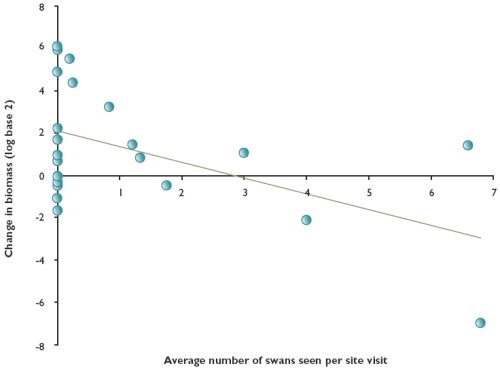Key finding
- Swan grazing pressure during the first half of the year has reduced the subsequent growth of Ranunculus.
Chalk rivers are characterised by their species-rich macrophyte communities, dominated by water crowfoot (Ranunculus). Traditionally, river keepers have carefully managed this plant to provide favourable conditions for angling, to control water levels and reduce flood risk. A national decline in Ranunculus, coupled with the apparent deterioration in the condition of chalk rivers prompted their UK Biodiversity Action Plan (BAP) status. A significant component of the BAP requires the maintenance of the Ranunculus community.
The issue of swan grazing on ranunculus has been a controversial subject on the River Wylye (a tributary of the Hampshire Avon in Wiltshire) and elsewhere, since the early 1970s. Where herds of non-breeding swans congregate, they can deplete Ranunculus beds by over-grazing, reducing structural and biological habitat diversity. The associated loss of weed-dependent invertebrates and cover for fish has made swans unpopular with the fly-fishermen.
Previous research on the Wylye sought to clarify aspects of swan population biology and to consider how the effects of grazing might be relieved. Currently Wessex Water have an invertebrate study on the Wylye, and its data are available to us, so we decided that the most useful approach would be to quantify the biomass of ranunculus that may be lost through grazing.
We monitored swans at 46 sites, at two-weekly intervals from January 2004. Sites were located approximately a kilometre apart and were randomly located relative to swans.
There is no established method to measure macrophtye biomass. Previously, Ranunculus has been measured by estimating its cover. However, this lacks precision, there are inconsistencies between observers and it ignores Ranunculus volume. Destructive sampling risks consuming what you are trying to measure and is labour intensive. We therefore devised a new method using percentage cover and small samples. The samples were oven-dried and this gave us an index of biomass at each site between May and September.
In spring 2004 the resident swans comprised 17 pairs and around 65 non-breeders, including two herds of approximately 15 and 40 swans respectively. From January to April 2004, the large herd appeared to feed almost exclusively on silage grass and oilseed rape adjacent to the river. During the breeding season, when Ranunculus started growing, aggressive behaviour by territorial cobs restricted the movements of non-breeders.
For each site we calculated Ranunculus growth rates and related these to swan presence. The number of swans present had a significant negative effect on biomass growth from May to July (see Figure 1). Biomass at some sites showed a steady decline. Where swan herds were active, this was more severe. At an 'average' site (i.e. mid-range in terms of starting biomass), biomass in July was halved by the presence of just one swan between January and June. The comparative approach across sites suggested no impact of swan numbers on change in biomass from July to the end of September. However, we believe that we missed the dramatic effect of herds at sites where we were unable to sample biomass for practical reasons.
Figure 1: Relationship between Ranunculus growth and number of swans at two sites between July and the end of September

This was a preliminary study. We would like to see more work to clarify the impact of swans on Ranunculus. We would also like to know the ecological and hydrological consequences of the 'lost' Ranunculus.